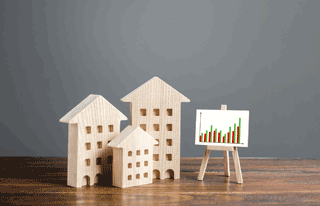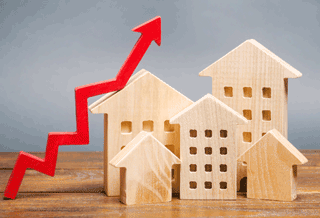Quote Of The Week
“We were expecting a drop in vacancies over January due to seasonality, however the drops were larger than expected. And worse for tenants, the weekly rental listings in February to date have fallen further for our largest cities.”
Louis Christopher, Managing Director of SQM Research
Rental Vacancy Rates Hit 16yr Low
 Vacancy rates continue to fall throughout Australia, with the national average rate hitting a 16-year low.
Vacancy rates continue to fall throughout Australia, with the national average rate hitting a 16-year low.
SQM Research reveals nationally the vacancy rate dropped to 1.3%, down by 0.3% during January. It puts the total number of vacant properties in Australia at just 47,977, down from 71,303 a year ago.
Vacancies in Perth, Adelaide, Canberra, Darwin and Hobart remain below 1%, while Brisbane is 1.1%, Sydney 2.1% and Melbourne 2.7%.
While vacancy rates in big city CBD markets remain higher, they also reduced during January to 4.5% in the Sydney CBD and 4% in the Melbourne CBD.
SQM managing director Louis Christopher predicts CBD rates will continue to fall as many staff return to offices in coming months. “We were expecting a drop in rental vacancies over January due to seasonality, however the drops were larger than expected,” he says.
Christopher says the shortage of rental properties is causing rent increases and he predicts rents will rise a further 10% this year.
House Prices Will Weather Rate Rise
 Bendigo & Adelaide Bank has joined the chorus of banks predicting an interest rate rise before the end of 2022, but expects property prices to continue rising.
Bendigo & Adelaide Bank has joined the chorus of banks predicting an interest rate rise before the end of 2022, but expects property prices to continue rising.
Managing director Marnie Baker predicts there will be further rate increases in 2023 and says the property market is well placed to handle the change.
Baker told The Australian that the bank is “very much leveraged to a rising cash rate environment”.
“Rate rises are becoming more likely as the data that’s dropping supports that view, along with the comments that are coming from the Reserve Bank,” she says.
Baker predicts continued property price increases although not at the same levels as in the past couple of years.
“There’s still scope, both in regional and metropolitan areas, for further price increases there,” she says.
In the December half year, Bendigo grew its share of the residential lending market and posted a cash profit of $260.7 million, with income up 2.9% to $873.4 million.
Auction Clearance Rates Keep Rising
 Constant media speculation of interest rates rises has done nothing to dampen buyer enthusiasm in the auction market, with the trend of rising clearance rates in the major cities continuing last weekend.
Constant media speculation of interest rates rises has done nothing to dampen buyer enthusiasm in the auction market, with the trend of rising clearance rates in the major cities continuing last weekend.
CoreLogic figures reveal the national clearance rate increased last week to 76%, the highest result since November 2021.
There were 2,405 homes offered for auction last week, 60% higher than at the same time last year.
Melbourne, where 1,033 auctions were held, recorded a clearance rate of 71%. Sydney, with 892 auctions, had its highest clearance rate since late October of 80%.
Of the smaller capital cities, Canberra had the highest result of 82% followed by Brisbane 81% and Adelaide 80%. Perth’s clearance rate was 73%.
Top sales included $10.4 million for a house at Bronte in Sydney’s eastern beaches, with four bidders still trying to secure it after it reached $10 million.
Ray White chief economist Nerida Conisbee says the results show the market is still very robust.
Building Cost Rises Impact Prices
 Property prices are tipped to increase further as builders are hit with the biggest surge in construction costs in 16 years.
Property prices are tipped to increase further as builders are hit with the biggest surge in construction costs in 16 years.
Nationally building costs increased by 7.3% last year, the highest annual increase since 2005.
CoreLogic warns that this could result in home prices and renovation costs continuing to rise in 2022.
Head of research Tim Lawless expects price growth to remain above average in the coming months, as a result of continued supply chain disruptions and above-average demand for new homes.
Demand for housing increased substantially during the pandemic as a result of the Federal Governments’ HomeBuilder grant with a significant amount of work in the pipeline.
“With some materials such as timber and metal products reportedly remaining in short supply, there is the possibility some residential projects will be delayed or run over budget,” Lawless says.
The biggest cost increases were in Western Australia and South Australia (7.9 %), followed by Queensland (7.3%), Victoria (7.1%) and NSW (7%).
PropTrack Predicts Price Increases
 Property prices will continue to rise in 2022 according to new market analysis from property data firm PropTrack.
Property prices will continue to rise in 2022 according to new market analysis from property data firm PropTrack.
PropTrack, a subsidiary of REA Group, predicts 6% to 9% increases in house prices across combined Australian capital cities this year.
Director of economic research Cameron Kusher says price growth was always going to soften a little in 2022, even without speculation of interest rate rises, after big growth in 2021.
“This will probably encourage more people to get their properties on to the market sooner and less likelihood of macroprudential policies being introduced to curb the exuberance in the market,” he says.
Economists are tipping rate rises at some stage in 2022 despite RBA Governor Philip Lowe saying it is not likely.
Analysis from CoreLogic indicates the impact of a rate rise will likely lag the rise itself. Comparing the relationship between rate changes and house prices from 2002 to 2022, CoreLogic found rate changes can take a year to be felt in the market.




